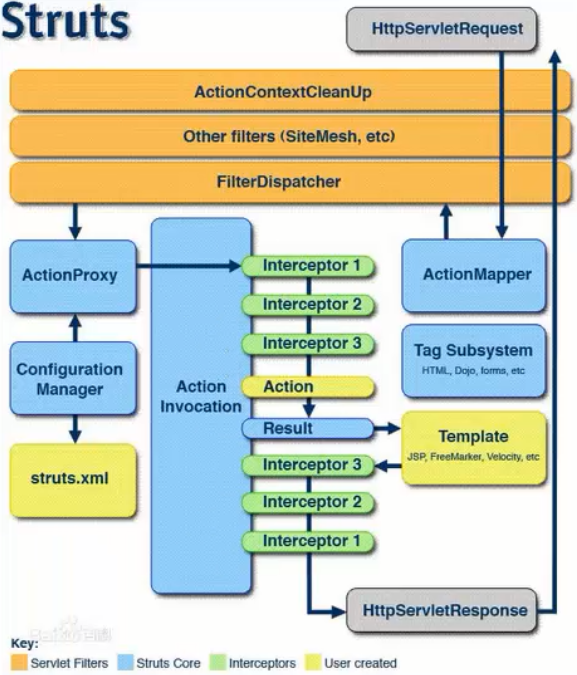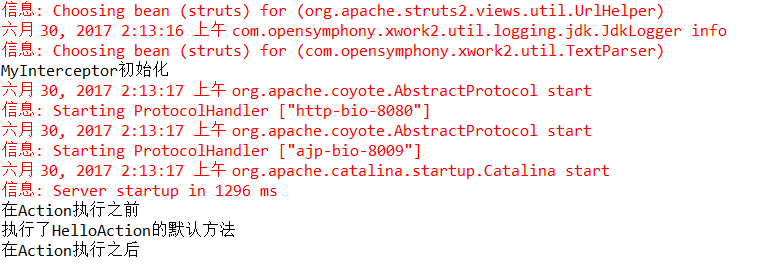Struts2 拦截器是在访问某个 Action 或 Action 的某个方法,字段之前或之后实施拦截,并且 Struts2 拦截器是可
插拔的,拦截器是AOP的一种实现.
优点:通用功能的封装,提供了可重用性;
二、Struts2预定义拦截器&拦截器栈
struts-default.xml中就有很多预定义的拦截器;
在执行action之前和之后,拦截器进行了操作;

拦截器栈:
interceptor-stack;
定义了一批拦截器;相当于把几个拦截器串起来;
struts-default.xml中定义了默认使用的拦截器栈:
<default-interceptor-ref name="defaultStack" />
三、自定义拦截器简单实例
com.cy.action.HelloAction.java:
package com.cy.action;
import com.opensymphony.xwork2.ActionSupport;
public class HelloAction extends ActionSupport{
/**
*
*/
private static final long serialVersionUID = 1L;
private String name;
public String getName() {
return name;
}
public void setName(String name) {
this.name = name;
}
@Override
public String execute() throws Exception {
System.out.println("执行了HelloAction的默认方法");
return SUCCESS;
}
}
com.cy.interceptor.MyInterceptor.java:
package com.cy.interceptor;
import com.opensymphony.xwork2.ActionInvocation;
import com.opensymphony.xwork2.interceptor.Interceptor;
public class MyInterceptor implements Interceptor{
//拦截器销毁的时候调用
public void destroy() {
System.out.println("MyInterceptor销毁");
}
//初始化的时候调用
public void init() {
System.out.println("MyInterceptor初始化");
}
//真正的调用
public String intercept(ActionInvocation invocation) throws Exception {
System.out.println("在Action执行之前");
String result = invocation.invoke(); //这里就是success,error啊啥的
System.out.println("在Action执行之后");
return result; //这个result也是要返回的,给配置文件看的。比如action中返回的是success,这边也返回success
}
}
struts.xml:
<?xml version="1.0" encoding="UTF-8" ?>
<!DOCTYPE struts PUBLIC
"-//Apache Software Foundation//DTD Struts Configuration 2.0//EN"
"http://struts.apache.org/dtds/struts-2.0.dtd">
<struts>
<package name="manage" namespace="/" extends="struts-default">
<interceptors>
<interceptor name="myInterceptor" class="com.cy.interceptor.MyInterceptor"></interceptor>
</interceptors>
<action name="hello" class="com.cy.action.HelloAction">
<result name="success">success.jsp</result>
<!-- 系统看到我们引用了拦截器myInterceptor就不会引用其他的拦截器/栈了,因此加上默认的拦截器
myInterceptor相当于最外层的,defaultStack相当于最里层的,顺序是先进入myInterceptor再是defaultStack
-->
<interceptor-ref name="myInterceptor"></interceptor-ref>
<interceptor-ref name="defaultStack"></interceptor-ref>
</action>
</package>
</struts>
success.jsp:
<body>
name: ${name}
</body>
测试结果:
启动tomcat,浏览器访问:http://localhost:8080/Struts2Chap01/hello?name=aaa
控制台打印结果:

系统运行的时候,通过读取配置文件,就有一个拦截器的初始化过程;
网址输入hello?name=aaa后,程序的执行过程:
1.进入MyInterceptor的intercept方法,打印:“在Action执行之前”;
2.执行HelloAction中的execute方法;执行完成;
3.MyInterceptor的intercept方法继续执行,打印:"在Action执行之后",返回结果;